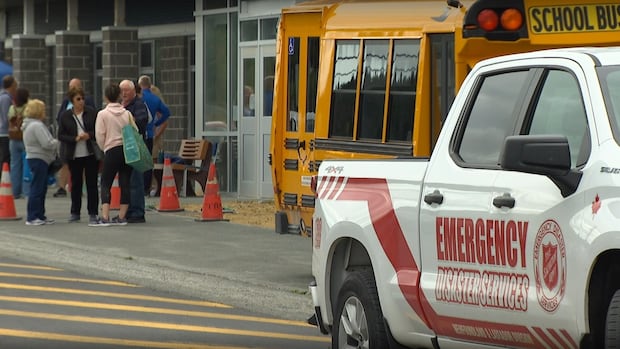Wildfires are disrupting back-to-school again. Experts call for support to plan for them

Families like Scott Chandler’s in Newfoundland are facing the aftermath of the Conception Bay North wildfires, which destroyed their home and his son Rhys’s school, Cabot Academy. As they navigate through different evacuation centers, Chandler is trying to maintain a sense of normalcy for his eight-year-old son, who is processing the loss of his belongings and school.
In the midst of these disasters, schools play a crucial role in providing support to communities. Alan Campbell, president of the Canadian School Boards Association, emphasizes the importance of maintaining communication with evacuated families to ensure that students can easily access schooling wherever they land. With the increasing frequency of environmental disruptions like wildfires, poor air quality, and extreme heat, schools need to be prepared to respond effectively.
Ali Asgary, a professor of disaster and emergency management at York University, stresses the need for schools to regularly update their emergency management plans and practice their response protocols. By staying proactive and ensuring that everyone is aware of what to do in emergency situations, schools can minimize disruptions to education and provide a safe learning environment for students.
As communities across Canada continue to face the challenges of natural disasters, it is essential for school boards and officials to prioritize emergency preparedness and response. By working together and staying vigilant, schools can help students like Rhys and his family navigate through difficult times and come out stronger on the other side.
Collaborative Efforts Needed to Ensure School Preparedness
Experts emphasize the importance of multi-level support and investment to enhance Canada’s school systems’ ability to effectively respond to disasters. Both Campbell and Asgary stress the need for assistance from various levels of government to ensure schools are adequately prepared and can mobilize swiftly in times of crisis.
As Asgary pointed out, expecting local schools to handle all aspects of disaster preparedness on their own is unrealistic. Support from upper levels of government, including federal assistance, is essential to supplement resources and expertise at the local level.
According to Campbell, a collaborative approach involving federal, provincial, and local authorities, as well as school boards, is crucial in tailoring responses to meet the specific needs of different communities. This coordinated effort is key to effectively addressing emergency management in schools.
Investing in Long-Term Solutions
Federal support for emergency management in schools is a step in the right direction, provided that decision-making powers remain decentralized to provincial, local, and school-board levels. Preserving local autonomy ensures that responses are tailored to the unique requirements of each community.
Chandler, a concerned parent from Newfoundland, commended the swift actions taken by school leaders to relocate students and teachers from Cabot Academy following a disaster. However, he emphasized the need for ongoing investment and support for affected individuals, including access to mental health professionals and therapists.
Looking ahead, Chandler hopes for a timely reunion of students and teachers to help them cope with the emotional toll of the disaster. He stresses the importance of providing comprehensive support to ensure that affected individuals can heal and rebuild together.
By fostering collaboration among various levels of government and investing in long-term solutions, Canada can strengthen its school systems’ resilience in the face of disasters and better support the well-being of students and educators. Together, we can work towards creating safer and more prepared learning environments for all.
the perspective of a travel blogger who just returned from a trip to Japan:
“Konichiwa! I just returned from an incredible trip to Japan and I can’t wait to share all of my adventures with you. From the bustling streets of Tokyo to the serene temples of Kyoto, Japan truly captured my heart.
One of the highlights of my trip was visiting the iconic Shibuya Crossing in Tokyo. This bustling intersection is known for its chaotic energy as hundreds of people cross the street in every direction. It was a surreal experience to be a part of the hustle and bustle and witness the organized chaos of Japanese city life.
I also had the opportunity to visit the historic city of Kyoto, known for its beautiful temples and traditional tea houses. One of my favorite moments was exploring the Fushimi Inari Shrine, with its stunning rows of torii gates leading up to the mountain. The peaceful atmosphere and stunning views made it a truly magical experience.
Of course, no trip to Japan would be complete without trying the delicious food. From sushi to ramen to tempura, I indulged in a culinary adventure that left me craving more. I even had the chance to try my hand at making sushi during a cooking class, which was a fun and delicious experience.
Overall, my trip to Japan was a whirlwind of culture, history, and incredible experiences. I can’t wait to return and explore more of this beautiful country. If you’re considering a trip to Japan, I highly recommend it – you won’t be disappointed!”



